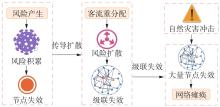| 1 |
AKBARZADEH M, MEMARMARMONTAERIN S, SYBIL D,et al .The role of travel demand and network centrality on the connectivity and resilience of an urban street system[J].Transportation,2019,46(5):1127-1141.
|
| 2 |
DENG Z P, HUANG D R, LIU J Y,et al .An assessment method for traffic state vulnerability based on a cloud model for urban road network traffic systems[J].IEEE Transactions on Intelligent Transportation Systems,2021,22(11):7155-7168.
|
| 3 |
MUKESH M, YASHWANT B, DIGAMBAR S .Analyzing the impact of floods on vehicular mobility along urban road networks using the multiple centrality assessment approach[J].Risk and Uncertainty in Engineering Systems:Part A-Civil Engineering,2022,8(3):05022001/1-12.
|
| 4 |
马超群,张爽,陈权,等 .客流特征视角下的轨道交通网络特征及其脆弱性[J].交通运输工程学报,2020,20(5):208-216.
|
|
MA Chaoqun, ZHANG Shuang, CHEN Quan,et al .Characteristics and vulnerability of rail transit network based on perspective of passenger flow characteristics[J].Journal of Traffic and Transportation Engineering,2020,20(5):208-216.
|
| 5 |
LU Q C, ZHANG L, XU P C,et al .Modeling network vulnerability of urban rail transit under cascading failures:a coupled map lattices approach [J].Reliability Engineering & System Safety,2022,221(7):108320/1-13.
|
| 6 |
ZHAO M, WANG X L, PAN W H,et al .The vulnerability analysis of the multi-layer air transport system[C]∥ Proceedings of the 5th International Conference on Transportation Information and Safety (ICTIS).Liverpool:ICTIS,2019:956-962.
|
| 7 |
LIU J, LU H P, MA H,et al .Network vulnerability analysis of rail transit plans in Beijng-Tianjin-Hebei region considering connectivity reliability [J].Sustainability,2017,9(8):1479/1-17.
|
| 8 |
沈犁,张殿业,向阳,等 .城市地铁-公交复合网络抗毁性与级联失效仿真[J].西南交通大学学报,2018,53(1):156-163,196.
|
|
SHEN Li, ZHANG Dianye, XIANG Yang,et al .Simulation on survivability and cascading failure propagation of urban subway-bus compound network[J].Journal of Southwest Jiaotong University,2018,53(1):156-163,196.
|
| 9 |
SONNAM J, GAO L, LIU F,et al .Cascading failure with preferential redistribution on bus-subway coupled network[J].International Journal of Modern Physics,2021,32(8):2150103/1-11.
|
| 10 |
ZHANG L, WEN H Y, LU J,et al .Exploring cascading reliability of multi-modal public transit network based on complex networks[J].Reliability Engineering & System Safety,2022,221:108367/1-27.
|
| 11 |
MA F, LIU F, YUEN K F,et al .Cascading failures and vulnerability evolution in bus-metro complex bilayer networks under rainstorm weather conditions[J].International Journal of Environmental Research and Public Health,2019,16(3):329/1-30.
|
| 12 |
宋英华,李玉枝,霍非舟,等 .城区内涝条件下城市公交-地铁双层交通网络的脆弱性分析[J].安全与环境工程,2021,28(2):114-120.
|
|
SONG Yinghua, LI Yuzhi, HUO Feizhou,et al .Vulnerability of two-layer traffic network of bus and subway under waterlogging condition based on complex network theory[J].Safety and Environmental Engineering,2021,28(2):114-120.
|
| 13 |
QI Q Y, KWON K .Exploring the characteristics of high-speed rail and air transportation networks in China:a weighted network approach[J].Journal of International Logistics and Trade,2021,19(2):96-114.
|
| 14 |
WANG B, SU Q, CHIN K S .Vulnerability assessment of China-Europe railway express multimodal transport network under cascading failures[J].Physic A:Statistical Mechanics and its Applications,2021,584:126359/1-14.
|
| 15 |
徐凤,朱金福,苗建军 .基于复杂网络的空铁复合网络的鲁棒性研究[J].复杂系统与复杂性科学,2015,12(1):40-45.
|
|
XU Feng, ZHU Jinfu, MIAO Jianjun .The robustness of high-speed railway and civil aviation compound network based on the complex network theory[J].Complex Systems and Complexity Science,2015,12(1):40-45.
|
| 16 |
强添纲,赵明明,裴玉龙 .城市多模式交通网络的复杂网络特性与鲁棒性研究[J].交通信息与安全,2019,37(1):65-71.
|
|
QIANG Tiangang, ZHAO Mingming, PEI Yulong .An analysis of characteristics of complex network and robustness in Harbin multi-mode traffic network[J].Journal of Transport Information and Safety,2019,37(1):65-71.
|
| 17 |
CHEN D J, FANG X F, LI Y,et al .Three-level multimodal transportation network for cross-regional emergency resources dispatch under demand and route reliability[J].Reliability Engineering & System Safety,2022,222:108461/1-14.
|
| 18 |
APARICIO J, ARSENIO E, HENRIQUES R .Assessing robustness in multimodal transportation systems:a case study in Lisbon[J].European Transport Research Review,2022,14(1):28/1-18.
|
| 19 |
彭翀,陈思宇,王宝强 .中断模拟下城市群网络结构韧性研究——以长江中游城市群客运网络为例[J].经济地理,2019,39(8):68-76.
|
|
PENG Chong, CHEN Siyu, WANG Baoqiang .Analyzing city network’s structural resilience under disruption scenarios:a case study of passenger transport network in the middle reaches of Yangtze river[J].Economic Geography,2019,39(8):68-76.
|
| 20 |
马书红,武亚俊,陈西芳 .城市群多模式交通网络结构韧性分析——以关中平原城市群为例[J].清华大学学报(自然科学版),2022,62(7):1228-1235.
|
|
MA Shuhong, WU Yajun, CHEN Xifang .Structural resilience of multimodal transportation networks in urban agglomerations:a case study of the Guanzhong plain urban agglomeration network[J].Journal of Tsinghua University (Science and Technology),2022,62(7):1228-1235.
|
| 21 |
侯兰功,孙继平 .复杂网络视角下的成渝城市群网络结构韧性演变[J].世界地理研究,2022,31(3):561-571.
|
|
HOU Langong, SUN Jiping .Evaluation of network structure resilience of Chengdu-Chongqing urban agglomeration from the perspective of complex networks[J].World Regional Studies,2022,31(3):561-571.
|
| 22 |
李成兵,张帅,杨志成,等 .蓄意攻击下城市群客运交通网络级联抗毁性仿真[J].交通运输系统工程与信息,2019,19(2):14-21.
|
|
LI Chengbing, ZHANG Shuai, YANG Zhicheng,et al .Invulnerability simulation in urban agglomeration passenger traffic network under targeted attacks[J].Journal of Transportation Systems Engineering and Information Technology,2019,19(2):14-21.
|
| 23 |
李成兵,魏磊,李奉孝,等 .基于攻击策略的城市群复合交通网络脆弱性研究[J].公路交通科技,2017,34(3):101-109.
|
|
LI Chengbing, WEI Lei, LI Fengxiao,et al .Study on vulnerability of city agglomeration compound traffic network based on attacks strategy[J].Journal of Highway and Transportation Research and Development,2017,34(3):101-109.
|
| 24 |
付焯,户佐安,邱忠权 .新冠肺炎疫情影响下多式联运网络突发事件风险传导机理[J].安全与环境学报,2021,21(5):1933-1940.
|
|
FU Chuo, LU Zuoan, QIU Zhongquan .Research on the risk transmission mechanism of multimodal transportation networks under the impact of the COVID 19 outbreak[J].Journal of Safety and Environment,2021,21(5):1933-1940.
|





















